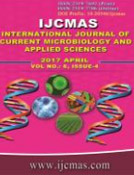


 National Academy of Agricultural Sciences (NAAS)
National Academy of Agricultural Sciences (NAAS)

|
PRINT ISSN : 2319-7692
Online ISSN : 2319-7706 Issues : 12 per year Publisher : Excellent Publishers Email : editorijcmas@gmail.com / submit@ijcmas.com Editor-in-chief: Dr.M.Prakash Index Copernicus ICV 2018: 95.39 NAAS RATING 2020: 5.38 |
Globally maize is the third most important crop in the world. The main maize crop is generally grown as rainfed and on marginal lands particularly in hilly terrains of the Kashmir valley. It is situated at longitude and latitude of 73.0-76.2E and 32.50-36.0N respectively. By 2050 demand for maize will double in the developing world, and maize is predicted to become the crop with the greatest production globally, and in the developing world by 2025 (Rosegrant et al., 2008). Heisey and Edmeades (1999) estimated that one quarter of the global maize area is affected by drought in any given year. Since farmers usually plant a single variety in any given field, this implies a need for a good level of drought tolerance in the large majority of hybrids and varieties grown under rainfed conditions. Drought is the major abiotic stress limiting maize production in large part of South and South-East Asia, and many other parts of the world. The drought stress accounted for approximately 16% loss of maize production in lowland tropics (Edmeades et al., 2006). Losses due to drought in lowland tropics averaged 17% (Edmeades et al., 1992), and it reached up to 60% in severely drought-affected regions/seasons (Rosen and Scott, 1992). In India, approximately 2.4 mha (~ 32.4%) of total maize growing areas is prone to face drought or excess moisture stress (AICRP, 2006). Selection and improvement under optimal conditions may not be suitable for the target areas prone to abiotic constraints (Simmonds, 1991). Therefore, in order to achieve improved and stable yields in stress prone environments it is desirable to improve tolerance to major abiotic constraints prevalent in target environment.
 |
 |
 |
 |
 |